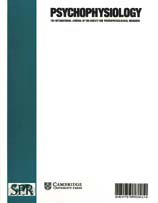Crossref Citations
This article has been cited by the following publications. This list is generated based on data provided by
Crossref.
Rudell, Alan P
and
Hu, Bin
2001.
Does a warning signal accelerate the processing of sensory information? Evidence from recognition potential responses to high and low frequency words.
International Journal of Psychophysiology,
Vol. 41,
Issue. 1,
p.
31.
Bazana, P. Gordon
and
Stelmack, Robert M.
2002.
Intelligence and information processing during an auditory discrimination task with backward masking: An event-related potential analysis..
Journal of Personality and Social Psychology,
Vol. 83,
Issue. 4,
p.
998.
Johnson, Ray
Barnhardt, Jack
and
Zhu, John
2003.
The deceptive response: effects of response conflict and strategic monitoring on the late positive component and episodic memory-related brain activity.
Biological Psychology,
Vol. 64,
Issue. 3,
p.
217.
Knott, Verner
Bradford, Lisa
Dulude, Louise
Millar, Anne
Alwahabi, Fahad
Lau, Tim
Shea, Catherine
and
Wiens, Andrew
2003.
Effects of Stimulus Modality and Response Mode on the P300 Event-Related Potential Differentiation of Young and Elderly Adults.
Clinical Electroencephalography,
Vol. 34,
Issue. 4,
p.
182.
Hatta, Arihiro
Nishihira, Yoshiaki
Kaneda, Takeshi
Wasaka, Toshiaki
Kida, Tetsuo
Kuroiwa, Kazuo
and
Akiyama, Sachiyo
2003.
Somatosensory Event-Related Potentials (ERPS) Associated with Stopping Ongoing Movement.
Perceptual and Motor Skills,
Vol. 97,
Issue. 3,
p.
895.
Hatta, Arihiro
Nishihira, Yoshiaki
Kaneda, Takeshi
Wasaka, Toshiaki
Kida, Tetsuo
Kuroiwa, Kazuo
and
Akiyama, Sachiyo
2003.
Somatosensory Event-Related Potentials (ERPS) Associated with Stopping Ongoing Movement.
Perceptual and Motor Skills,
Vol. 97,
Issue. 3,
p.
895.
Rammsayer, Thomas
and
Stahl, Jutta
2004.
Extraversion-related differences in response organization: evidence from lateralized readiness potentials.
Biological Psychology,
Vol. 66,
Issue. 1,
p.
35.
Nakata, Hiroki
Inui, Koji
Wasaka, Toshiaki
Tamura, Yohei
Kida, Tetsuo
and
Kakigi, Ryusuke
2005.
Effects of ISI and stimulus probability on event-related go/nogo potentials after somatosensory stimulation.
Experimental Brain Research,
Vol. 162,
Issue. 3,
p.
293.
Roman, Robert
Brázdil, Milan
Jurák, Pavel
Rektor, Ivan
and
Kukleta, Miloslav
2005.
Intracerebral P3-like waveforms and the length of the stimulus–response interval in a visual oddball paradigm.
Clinical Neurophysiology,
Vol. 116,
Issue. 1,
p.
160.
Marzilli, Thomas
Willhoit, Kristin Florence
and
Guadagnoli, Mark
2006.
Effects of information processing load in abstinent and nonabstinent smokers' psychomotor task performance.
Nicotine & Tobacco Research,
Vol. 8,
Issue. 3,
p.
425.
Beauchamp, Chris M.
and
Stelmack, Robert M.
2006.
The chronometry of mental ability: An event-related potential analysis of an auditory oddball discrimination task.
Intelligence,
Vol. 34,
Issue. 6,
p.
571.
Kamijo, Keita
Nishihira, Yoshiaki
Higashiura, Takuro
and
Kuroiwa, Kazuo
2007.
The interactive effect of exercise intensity and task difficulty on human cognitive processing.
International Journal of Psychophysiology,
Vol. 65,
Issue. 2,
p.
114.
Nessler, Doreen
Friedman, David
Johnson, Ray
and
Bersick, Michael
2007.
ERPs suggest that age affects cognitive control but not response conflict detection.
Neurobiology of Aging,
Vol. 28,
Issue. 11,
p.
1769.
Russo, Paolo M.
De Pascalis, Vilfredo
Varriale, Vincenzo
and
Barratt, Ernest S.
2008.
Impulsivity, intelligence and P300 wave: An empirical study.
International Journal of Psychophysiology,
Vol. 69,
Issue. 2,
p.
112.
De Pascalis, V.
Varriale, V.
and
Matteoli, A.
2008.
Intelligence and P3 components of the event-related potential elicited during an auditory discrimination task with masking.
Intelligence,
Vol. 36,
Issue. 1,
p.
35.
Azizian, Allen
Freitas, Antonio L.
and
Squires, Nancy K.
2008.
Varieties of action control: Event-related brain potentials of responding to symbolically congruent and incongruent cues.
Physiology & Behavior,
Vol. 93,
Issue. 4-5,
p.
905.
Sakamoto, Kiwako
Nakata, Hiroki
and
Kakigi, Ryusuke
2009.
The effect of mastication on human cognitive processing: A study using event-related potentials.
Clinical Neurophysiology,
Vol. 120,
Issue. 1,
p.
41.
Tu, Shen
Li, Hong
Jou, Jerwen
Zhang, Qinglin
Wang, Ting
Yu, Caiyun
and
Qiu, Jiang
2009.
An event-related potential study of deception to self preferences.
Brain Research,
Vol. 1247,
Issue. ,
p.
142.
KAMIJO, KEITA
NISHIHIRA, YOSHIAKI
and
HIGASHIURA, TAKURO
2009.
EFFECTS OFEXERCISE INTENSITY AND PHYSICAL ACTIVITY LEVELS ON THE BRAIN AND COGNITION.
Japanese Journal of Physical Fitness and Sports Medicine,
Vol. 58,
Issue. 1,
p.
63.
Kamijo, K.
Hayashi, Y.
Sakai, T.
Yahiro, T.
Tanaka, K.
and
Nishihira, Y.
2009.
Acute Effects of Aerobic Exercise on Cognitive Function in Older Adults.
The Journals of Gerontology Series B: Psychological Sciences and Social Sciences,
Vol. 64B,
Issue. 3,
p.
356.




